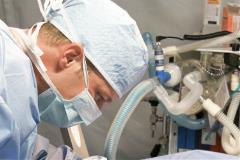Advising Clients of the Procedures and Tools Utilized During a Dental Prophylaxis

An established routine focused on maintaining good dental care is essential to the health of companion pets. Dental issues left undiagnosed and untreated will reduce an animal’s quality of life when infection, pain, and disease occur. Creating client awareness of the benefits provided by a dental prophylaxis may help to better their understanding of the need for good dental care.
Purpose of a Dental Prophylaxis
The purpose of a dental prophylaxis is to:
- Clean the teeth above and below the gum line
- Evaluate the oral cavity for any signs of disease or problems
Steps Involved
The American Veterinary Dental Society (AVDS) recommends the following when completing a dental prophylaxis:
Comfort and Safety
- Animal is placed under general anesthetic in order to:
- Increase patient comfort
- Establish a more effective cleaning and examination outcome
- Allow for placement of an endotracheal tube which protects the animal’s lungs from oral bacteria
- Veterinarians and technicians dress safely, donning protective:
- Eyewear
- Gloves
- Clothing
Basic Steps of a Dental Prophylaxis Procedure
- Supragingival cleaning
- Cleaning the area above the gum line
- Often completed with mechanical scalers
- Benefits the animal by increasing the speed of the cleaning which decreases the animal’s time under anesthesia
- Subgingival cleaning
- Cleaning the area under the gum line
- Removes plaque and calculus
- Polishing
- The cleaning procedure to remove plaque and calculus actually roughens the tooth surface which hastens the adherence and build-up rate of new plaque and calculus
- Polishing a tooth removes the roughened surface which decreases the adherence ability of new plaque and calculus
- Subgingival/Sulcal lavage
- The process of scaling and polishing often traps bacteria and debris underneath the gum line
- Flushing the gingiva with either antibacterial or saline solutions:
- Removes the trapped debris
- Reduces chance of local inflammation and future periodontal disease
- Fluoride treatment
- Treating the tooth with a fluoride foam is recommended. The fluoride:
- Hardens the dentin
- Decreases sensitivity
- Fights plaque
- Retards the formation of feline oral resorptive lesions
- Treating the tooth with a fluoride foam is recommended. The fluoride:
- Evaluation
- The next step in this dental procedure is to evaluate the teeth and oral cavity, which requires:
- Periodontal probe
- Detects unwanted periodontal pockets
- Dental radiographs
- Identifies and determines extent of any disease
- Establishing a Plan
- Utilizing all of the information gathered during the dental procedure, a plan to address the animal’s oral health needs can now be developed
- Periodontal probe
- The next step in this dental procedure is to evaluate the teeth and oral cavity, which requires:
- Charting
- Information relative to the current and future dental health of the animal is charted within their permanent medical record
Tools
Identifying the tools used during the dental prophylaxis will help clients fully understand the process.
- Prophy kit
- Collection of the instruments used to complete the procedure
- Tools include:
- Dental mirrors
- Provides indirect vision and illumination ability in areas of the mouth that are otherwise difficult to see
- Can also serve as a cheek retractor
- Mirrors typically come in sizes that fit the size of the animal
- Probes
- Examine teeth
- Measure pocket depths
- Explorers
- Identify presence of caries
- Detect calculus
- Exploration of furcations, restorations and pocket characteristics
- Scalers
- Used above the gum line
- Remove calculus and deposits
- Curettes
- Used below the gum line
- Scaling, root planing, periodontal debridement
- Dental mirrors
Advising clients on what to expect during their pet’s dental prophylaxis could help to create awareness of the importance for routine dental care. If you are interested in hearing more about dental care tools and procedures, please contact your Covetrus representative at 855.724.3461
Sources:


Working Here
Our team members are encouraged to be the best they can be... at Covetrus we believe we impact one another.
Learn MoreNews & Events
FDA Cautions Pet Owners Not to Feed Texas Tripe Inc. Raw Pet Food Due to Salmonella, Listeria Monocytogenes
The U.S. Food and Drug Administration is cautioning pet owners not to feed their pets any of the Texas Tripe brand raw frozen pet food listed below because several samples of Texas Tripe raw pet food have tested positive for Salmonella and/or L. mono.
Careers
Are you looking for a place to let your talents shine? At Covetrus, we help our practitioner customers better serve their patients and take pride in providing the best customer experience possible. Search our open positions to see our available opportunities.
Newsletter
Stay current with what’s going on with Covetrus, subscribe to receive our newsletter and email communications. Subscribers will receive the latest information in practice management, sales and marketing, animal health, and more.



-3-(1).png?sfvrsn=2d806d73_0)

Leave a comment